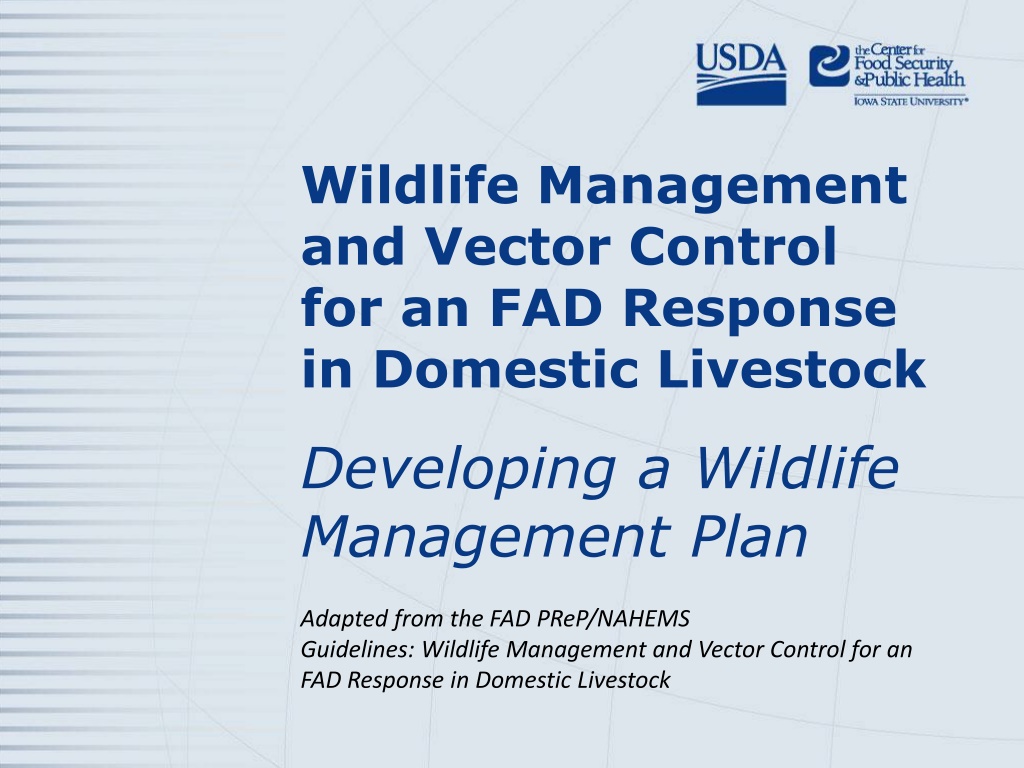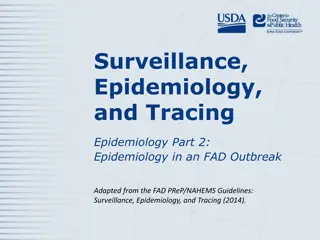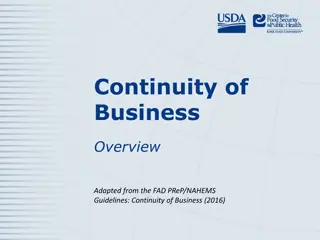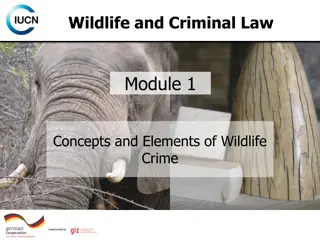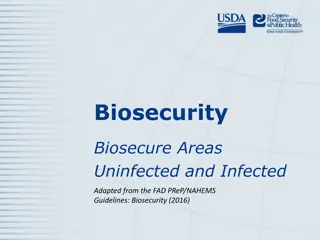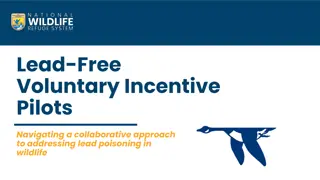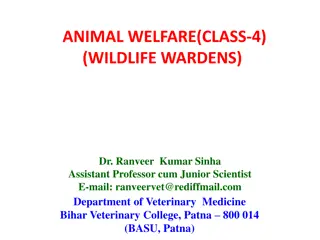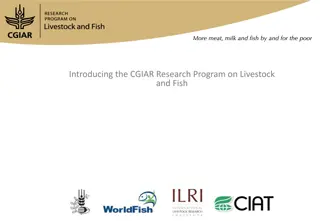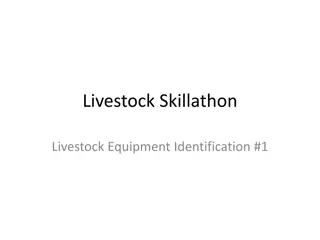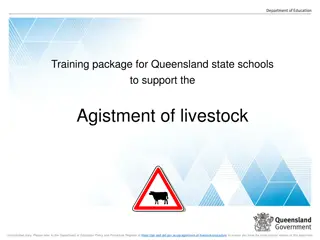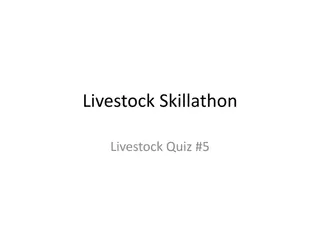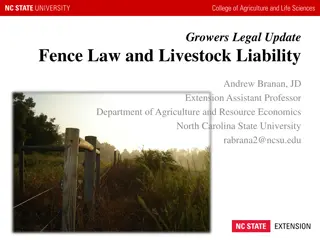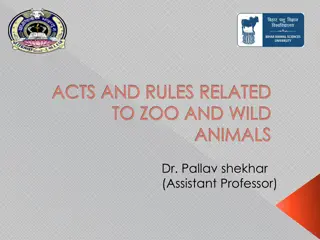Developing a Wildlife Management Plan for FAD Response in Livestock
This presentation outlines the development of a wildlife management plan for responding to Foreign Animal Diseases (FAD) in domestic livestock. It covers key considerations, objectives, factors to consider, and the role of personnel and equipment in managing wildlife and vector control during disease outbreaks.
Download Presentation

Please find below an Image/Link to download the presentation.
The content on the website is provided AS IS for your information and personal use only. It may not be sold, licensed, or shared on other websites without obtaining consent from the author. Download presentation by click this link. If you encounter any issues during the download, it is possible that the publisher has removed the file from their server.
E N D
Presentation Transcript
Wildlife Management and Vector Control for an FAD Response in Domestic Livestock Developing a Wildlife Management Plan Adapted from the FAD PReP/NAHEMS Guidelines: Wildlife Management and Vector Control for an FAD Response in Domestic Livestock
This Presentation Developing a management plan for wildlife Epidemiology Ecology Resources Socio-political Controlling vectors to spread diseases Other ongoing activities 2 FAD PReP/NAHEMS Guidelines: Wildlife, Vector Control - Management Plan USDA APHIS and CFSPH
General Considerations in Plan Development
Objectives Short-term Containing, controlling outbreak in domestic livestock Long-term Eradicate FAD Unintended consequences Animal welfare, occupational health, chemical use, environment, non-targeted animals/species, public opinion Demonstrating disease freedom If required for OIE-free status/trading partners 4 FAD PReP/NAHEMS Guidelines: Wildlife, Vector Control - Management Plan USDA APHIS and CFSPH
Factors to Consider Epidemiology Study distribution of disease Data, observations of animals Ecology Location, habitat, seasonal social/feeding behavior Resources Availability, personnel, equipment Socio-political Economy, law, regulation, public opinion, safety 5 FAD PReP/NAHEMS Guidelines: Wildlife, Vector Control - Management Plan USDA APHIS and CFSPH
Personnel - Hazards Trained/experienced personnel Safety Officer - safe work procedures Potential hazards Physical Environmental Psychological Zoonotic diseases Avoid unnecessary exposure/use PPE Report unsafe working conditions 6 FAD PReP/NAHEMS Guidelines: Wildlife, Vector Control - Management Plan USDA APHIS and CFSPH
Equipment, Information Reporting Required equipment Depends on specific situation, conditions Nothing unessential Biosecurity, cleaning and disinfection, safety, proficiency Compliance with laws Information reporting Collect, manage, store, analyze, disseminate 7 FAD PReP/NAHEMS Guidelines: Wildlife, Vector Control - Management Plan USDA APHIS and CFSPH
Vector Control in an FAD Outbreak in Domestic Livestock
Vector-Borne Diseases 9 FAD PReP/NAHEMS Guidelines: Wildlife, Vector Control - Management Plan USDA APHIS and CFSPH
Vector-Borne Diseases contd 10 FAD PReP/NAHEMS Guidelines: Wildlife, Vector Control - Management Plan USDA APHIS and CFSPH
Authority for Vector Control Local authorities Public health leads for human health APHIS coordinates on control strategies Pesticides registered with EPA, FIFRA And possibly States APHIS collaborates with CDC in vector-borne FAD outbreaks which involve public health 11 FAD PReP/NAHEMS Guidelines: Wildlife, Vector Control - Management Plan USDA APHIS and CFSPH
Methods of Vector Control Prevent, eliminate vector populations Understand life cycle and relationship to host and pathogen More efficient to control egg, larva than adult Focus on habitat reduction, minimizing contact, chemical control, biological control 12 FAD PReP/NAHEMS Guidelines: Wildlife, Vector Control - Management Plan USDA APHIS and CFSPH
Methods of Vector Control contd Habitat reduction Change vector-required conditions Minimizing contact Limit exposure to habitat or during activity Chemical control Supplemental measure Apply to vector habitat, to animal, or feed as insect growth regulators Biological control Release agents or natural predators 13 FAD PReP/NAHEMS Guidelines: Wildlife, Vector Control - Management Plan USDA APHIS and CFSPH
Arthropod Vectors of FADs Biting midges Also called no-see-ums , blood feeders Require moisture for larvae, pupae Limit moist areas, use insecticide mist Mosquitoes Require moisture for larvae, pupae Eliminate standing water, reduce weeds, stock fish Only use approved larvicides 14 FAD PReP/NAHEMS Guidelines: Wildlife, Vector Control - Management Plan USDA APHIS and CFSPH
Arthropod Vectors of FADs contd Ticks Arachnids, persistent blood suckers Feed for long periods, transmitting diseases Hard ticks, soft ticks Mow vegetation around buildings Flies Require moisture for eggs Control wet areas Residual sprays, strips, tapes, traps 15 FAD PReP/NAHEMS Guidelines: Wildlife, Vector Control - Management Plan USDA APHIS and CFSPH
Quarantine and Movement Control Control Area established by Incident Command Infected Zone+Buffer Zone Personnel, wildlife, product movement must adhere to guidelines Extensive mitigation activities for wildlife reservoirs in Control Area 17 FAD PReP/NAHEMS Guidelines: Wildlife, Vector Control - Management Plan USDA APHIS and CFSPH
Health, Safety, Communication Health, Safety - PPE Personnel safety is critical Protect from zoonotic, physical, environmental, psychological hazards Communication Public support necessary Many groups affected by FAD outbreak Public Information Officer handles media, public statements 18 FAD PReP/NAHEMS Guidelines: Wildlife, Vector Control - Management Plan USDA APHIS and CFSPH
Biosecurity, C&D Biosecurity Prevent FAD introduction Standard practice Cleaning and disinfection Procedures remove, inactivate, reduce, destroy disease agents Apply to personnel, vehicles, equipment, supplies 19 FAD PReP/NAHEMS Guidelines: Wildlife, Vector Control - Management Plan USDA APHIS and CFSPH
Euthanasia/Depopulation May be necessary Treat humanely at all times Reduce pain, distress to greatest extent Use accepted methods for euthanasia Follow proper carcass disposal protocols 20 FAD PReP/NAHEMS Guidelines: Wildlife, Vector Control - Management Plan USDA APHIS and CFSPH
For More Information FAD PReP/NAHEMS Guidelines: Wildlife Management and Vector Control for an FAD Response in Domestic Livestock http://www.aphis.usda.gov/fadprep Wildlife Management and Vector Control web-based training module Coming soon 21 USDA APHIS and CFSPH FAD PReP/NAHEMS Guidelines: Wildlife, Vector Control - Management Plan
Guidelines Content Authors (CFSPH) Glenda Dvorak, DVM, MS, MPH, DACVPM Nicole Seda, BS Meghan Blankenship, BS Heather Allen, PhD, MPA Contributor (USDA) Jonathan Zack, DVM 22 FAD PReP/NAHEMS Guidelines: Wildlife, Vector Control - Management Plan USDA APHIS and CFSPH
Guidelines Content Reviewers (USDA) Randall Levings, DVM, MS Randall Crom, DVM Michael Messenger, PhD Michael David MS, VMD, MPH Wildlife Disease Steering Committee Subject Matter Experts Claudio L. Afonso Samantha Gibbs, DVM, PhD D. Scott McVey, DVM, PhD, DACVM David Suarez, DVM 23 FAD PReP/NAHEMS Guidelines: Wildlife, Vector Control - Management Plan USDA APHIS and CFSPH
Acknowledgments Development of this presentation was by the Center for Food Security and Public Health at Iowa State University through funding from the USDA APHIS Veterinary Services PPT Authors: Abbey Smith, Student Intern; Janice Mogan, DVM Reviewers: Glenda Dvorak, DVM, MPH, DACVPM; Heather Allen, PhD, MPA
